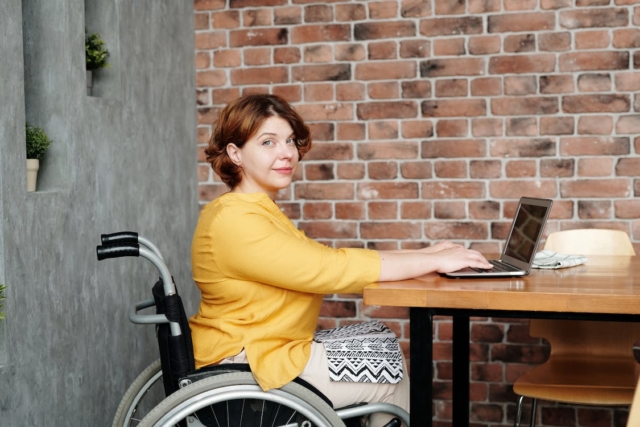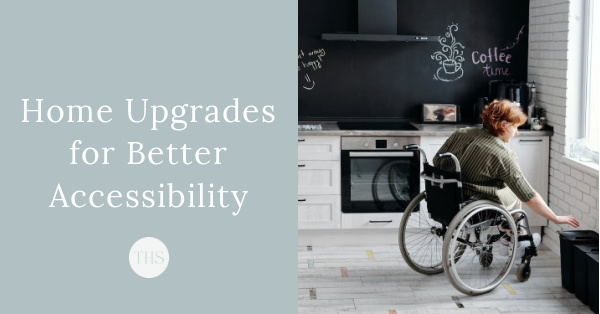Bored & Sick: 30 Entertaining Things You Can Do at Home Alone

This article is written by Miles Oliver.
Making your home accessible can be fun and relatively easy if you plan correctly. There are small changes that can make all the difference for anyone in the home with accessibility needs, especially as 48 million households in the U.S. have at least one member that is either over 65 years old, lives with a disability, or both. Keeping accessibility needs in mind and making small adjustments to your home will improve their quality of life and show how much you care.
Whether you or someone you love is living with accessibility needs, you can make changes to your home that can help. Even if you don’t currently know anyone with accessibility considerations, adding these small accessibility modifications is just a good idea all around.
Accessibility considerations typically bring to mind wheelchair ramps and stairlifts. However, there are all kinds of accessibility updates you can make to your home, large and small. Consider all types of different lifestyles and how you can improve things around your home to make them more accessible or more comfortable for people with those lifestyles.
For example, if you or someone you love is living with a chronic illness, compassion can go a long way. Your home should be a sanctuary and conducive to healing. Optimizing your home for healing includes little changes that can make all the difference in whether or not you take steps to improve your health. For instance, you can switch around your kitchen so that healthier foods are easier to reach.
Not only can home accessibility help with a healthier lifestyle, but it can also boost the value of your home. Certain upgrades, like adding improved lighting, installing an HVAC system, upgrading the bathroom or kitchen, and installing new, sealed windows, will benefit household members — currently and in the future.
You may think you have to wait until the weather is temperate in order to upgrade your house. However, there are subtle changes you can make in any season as long as you adequately prepare. This will also depend on the area in which you live and whether it receives inclement weather.
If you have hired a contractor, you have to wait for inclement weather to pass. You can save money by doing the smaller projects yourself. Installing smaller home upgrades in any season allows you the flexibility to do so whenever you have time and are feeling up for it physically. Just pick an area of the home that isn’t open to the elements to start updating at any time.

When choosing where to make these subtle accessibility changes, think about the areas of the home you use the most. Ask yourself:
Also, don’t forget to put yourself first when making renovations. After all, that’s why you’re making the changes. Continue to ask yourself:
Check-in with yourself along the way. If the renovations are too taxing, the end goal might not be worth it. Weigh the pros and cons. Typically, if you can get some help and make subtle changes to your home, it will be worth the effort in the long run. Remember to think about the perks of simplifying daily tasks for yourself and your household members and how this will impact you and them over time — mentally and physically. Less strain on your body and mind is never a bad thing.
The bathroom has a unique set of challenges when it comes to accessibility and safety. The floors are typically slippery, the sink is high, the handles are hard to reach and turn, and the toilet is low to the ground. Luckily, there are quick bathroom upgrades you can make instead of a complete overhaul.
Some ideas for subtle changes in your bathroom that help with accessibility include:
When using the bathroom daily, think about what would make tasks easier for you and your loved ones. Figure out the ideal placement for items you use every day, like soap and towel racks. You can also raise the toilet seat, as many people have issues bending down. If the water from the sink and tub/shower can become scalding and the faucets are too difficult to use quickly, changing the handles and tweaking your hot water heater could be a life-saving fix.

In addition to regulating the temperature of your water heater, you can also adjust the temperature inside your home. As mentioned above, having properly sealed windows can save you money on electric bills by keeping your spaces more insulated. What’s more, if you or your household members have a condition that is affected by body temperature, it will be easier to regulate the comfort of your living spaces.
For example, people living with Raynaud’s syndrome need to keep their extremities warm to stay healthy. Sealing windows and installing a proper HVAC system can help prevent illness complications. Add a basket with blankets or handheld fans that are easy to reach if you are on a strict budget. You can also install remote-controlled heating and air conditioning units so that the controls are easier to reach and adjust by everyone in the household.
Controls can often be finicky. Pay attention to how lighting is controlled in your home and how it could be improved for those with accessibility needs. For example, you could install:
The temperature and brightness of lights can often affect those with migraines or sensory differences. Allowing the controls to be easily accessible adds to the level of comfort in your home.
After you make some upgrades, take note of how they affect your day-to-day life in your home. You can even ask for feedback from other members of the household or guests on what could make them more comfortable. Your home will be happier for it.
For more practical tips, check out 27 subtle ways to optimize your home for healing or how to get (and stay!) organized when you’re living with chronic illness.